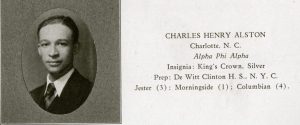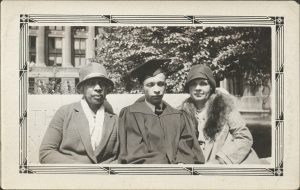In 2018, Columbian Denise Murrell GSAS PhD 2014 was the curator of the Wallach Art Gallery’s “Posing modernity : the black model from Manet and Matisse to today.” Following this well-received show, her latest exhibition, The Harlem Renaissance and Transatlantic Modernism, opens at the Metropolitan Museum of Art on February 25, 2024. Among the many works in this long-overdue show, Murrell features one painting from the Met’s own collection, Girl in a Red Dress, by another Columbian, Charles Henry Alston CC 1929, TC MA 1931.
Charles Henry Alston (1907-1977) was a painter, sculptor, illustrator, muralist and art educator. In 1935, he was the first African American WPA project supervisor, leading a staff of 35 artists and assistants to create the Harlem Hospital Center murals. Alston was also the first Black instructor at the Art Students League of New York (1950-1971) and the Museum of Modern Art (1956) and he was a member of the art faculty at City College of New York for over 15 years. But before his works became part of the permanent collections at the Metropolitan Museum of Art and the Whitney Museum of American Art, Charles Alston was a Columbia College student.

Alston graduated from the DeWitt Clinton High School (Clinton was a member of the Columbia College Class of 1786), where he had been active as the art editor of the school’s magazine The Magpie. Arriving on campus in the fall of 1925, Alston quickly joined the Art Board of the Jester, the satirical humor magazine, and the staff of the Columbian, the yearbook. In his senior year, he moved from the Jester to Morningside, an independent campus literary magazine, where he produced woodcuts for the covers.

In 1929, the Columbian was dedicated to Columbiana Curator Robert Arrowsmith, CC 1882, and it is Alston’s portrait of the man which takes pride of place. The student newspaper Spectator praised the yearbook: “If simplicity and lack of pretentious gaudiness may be considered virtues in a college year book, the 1929 Columbian will be long remembered as an outstanding example of excellence in its field.” And in particular, they praised Alston’s woodcut of Arrowsmith, “a fine likeness to those of us who were privileged to know that fine gentleman before an untimely death took him from us.”

The Alumni Federation card boldly states what the official student record does not: Alston was a Black student in a predominantly White institution and his student experience differed from that of most of his classmates. For example, Alston was a member of the Alpha Phi Alpha fraternity. The then-Black-only student group was not part of the Greek system at Columbia. This chapter was “unofficial” at Columbia, that is, Alpha Phi Alpha was outside the University administration and was not part of the interfraternity council Pamphratria. Neither a membership photograph nor even a list of members is included in the yearbook. The Alpha Phi Alpha “unofficial” chapter closed after World War II but was reactivated in 1967. This later chapter has been “official” since 1968 and is currently part of Columbia’s Multicultural Greek Council.

Alston had originally considered a pre-architecture concentration and later pre-med. After he was done with his general education or core curriculum classes, Alston enrolled in art history and fine art classes in the fall of 1927. As a student in Fine Arts 11-12, the yearlong sequence in Drawing and Design with Professor Joseph Lauber, Alston recalled how, as a Black student, he was not permitted to draw from the nude (presumably White) female model. But because life drawing was a required part of the course, he was told that he had been exempted from this requirement “on the alleged grounds that he had been rated ‘excellent’ in still life drawing.” [1]
After graduation, Alston became director of the boys’ program at the Utopia Children’s House, where he discovered a 10-year-old Jacob Lawrence in the after-school arts and crafts program. He later received the Arthur Wesley Dow Fellowship which enabled him to complete a Master’s degree in Fine Arts Education at Teachers College in 1931. He received a Distinguished Alumnus Award from Teachers College in 1975, the first year the award was offered.
The University Archives has copies of the student publications Jester, Morningside and The Columbian featuring his artwork. Columbia College Today, the alumni magazine, has featured Alston in two profiles: after the artist’s show at New York’s Gallery of Modern Art in 1969 and again in 2018 when Alston’s work was included in the Wallach Art Gallery’s exhibition “Posing Modernity: The Black Model from Manet and Matisse to Today.”

The Archives of American Art holds the Charles H. Alston papers, which include both the graduation photo above and Alston’s undergraduate transcript. The entirety of this collection is available online. The Southern Historical Collection at the University of North Carolina Library also holds their own Charles Henry Alston papers.
[1] Bearden, Romare and Harry Henderson. A history of African-American artists, from 1792 to the present. New York: Pantheon Books, 1993, 261. This version is based on a 1969 oral history interview. Alston also tells a version of this event in the 1968 oral history interview at the Archives of American Art.
This post is an update on an earlier version from March 2021.